Nvidia RTX 4060
Rated: 8.9/10
Intel Arc A770
Rated: 8.3/10
Pros And Cons
| GPU | Pros | Cons |
|---|---|---|
| Nvidia RTX 4060 | ✅Superior gaming performance ✅Better power efficiency | ❌Slightly higher average temperatures |
| Intel Arc A770 | ✅Lower temperatures during gaming sessions ✅Potentially more affordable | ❌Higher power consumption |
- The RTX 4060 outperforms the Arc A770 significantly in most gaming scenarios, with an average framerate advantage of approximately 13% across various titles.
- Although manufactured using a more advanced 6nm process, the Arc A770 consumes approximately 69% more power on average than the RTX 4060.
- The RTX 4060 demonstrates superior thermal efficiency, operating at an average temperature of approximately 10% cooler than the Arc A770 in gaming scenarios.
- The RTX 4060 is currently priced at $295, representing a 1.3% lower cost than the Arc A770, which is available at $299.
Comparison Table
| Technical Specs | Intel Arc A770 | Nvidia RTX 4060 |
|---|---|---|
| GPU | DG2-512 | AD107 |
| Architecture | Generation 12.7 | Ada Lovelace |
| CUDA Cores | 4096 | 3072 |
| Compute Units | 512 | 96 |
| RT Cores | 32 | 24 |
| TMUs | 160 | 96 |
| ROPs | 128 | 32 |
| Memory Speed | 512.0 GB/s | 272.0 GB/s |
| Best Variants | – | Best RTX 4060 |
Architectural Differences
- Process Size: The Intel Arc A770 is based on a 6nm process size, while the Nvidia RTX 4060 utilizes a more advanced 5nm process size, helping it be more power efficient.
- Clock Speeds: The base clock of the Intel Arc A770 is 2100MHz, with a boost clock of 2400MHz. The Nvidia RTX 4060 has a base clock of 1830MHz and a boost clock of 2460MHz.
- VRAM: The Intel Arc A770 features 16GB of GDDR6 VRAM. The Nvidia RTX 4060 has 8GB of GDDR6 VRAM.
- Bus Width: The Intel Arc A770 has a wide 256-bit memory bus. On the other hand, the Nvidia RTX 4060 has a narrower 128-bit bus width.
- TDP: The Intel Arc A770 has a TDP of 225W. In comparison, the Nvidia RTX 4060 has a significantly lower TDP of 115W.
- Other Features: Both the RTX and Arc card have RT cores, though they are much more mature on the RTX 4060. The Upscaling implementation is also more impressive on the 4060, using frame generation technology in the latest DLSS 3.
In this comparison, we will compare the RTX 4060 to the Intel Arc A770. Come along with us as we explore different tests, details about technology, and advice from experts to figure out which graphics card is the best for gaming.
Gaming Performance Benchmarks
Now that we’ve examined the core specifications of each card, in this section, where we compare the RTX 4060 vs Arc A770, we will look at the performance of these cards in realistic gaming scenarios.
Testing Rig
- OS – Windows 11
- CPU – Intel Core i5-13600K
- Motherboard – ASRock B650E PG-ITX WIFI Motherboard
- RAM – XPG Lancer RGB 32GB 7200MHz DDR5 Ram
- CPU Cooler – Deepcool Assassin II CPU Cooler
- SSD – XPG GAMMIX S70 BLADE 2TB NVMe SSD
- Power Supply – ENERMAX REVOLUTION D.F. X 1050W
Hogwarts Legacy (RT On, DLSS 3/XeSS Q)
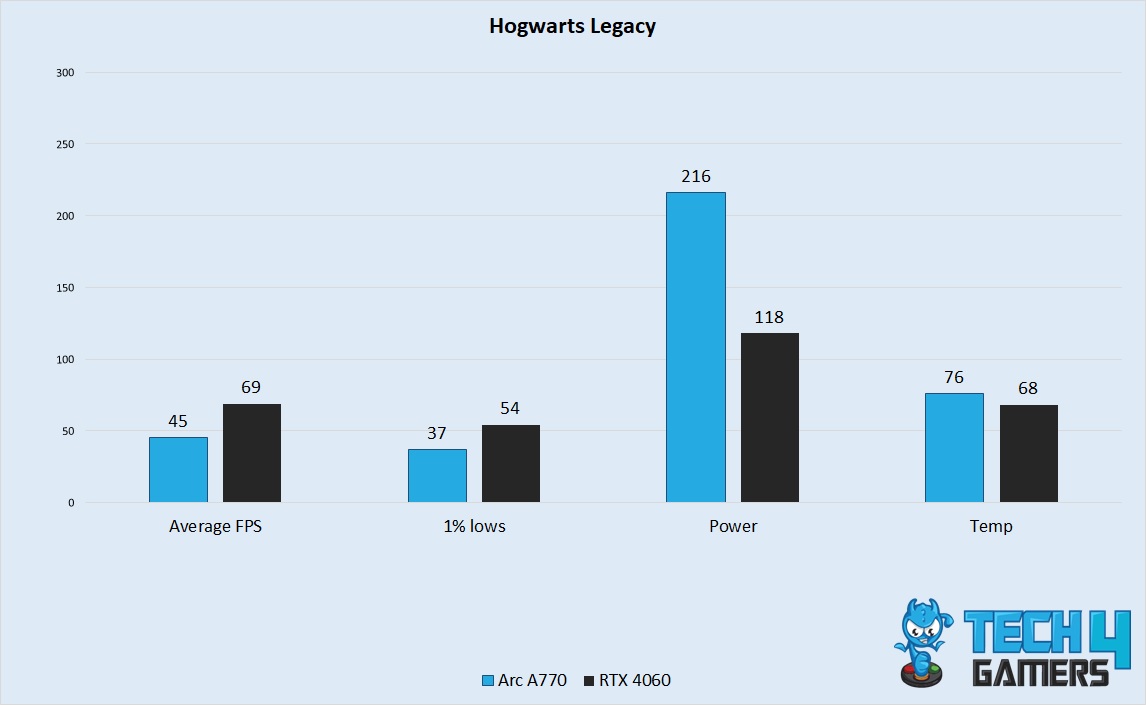
- In the first game of our benchmark tests, the RTX 4060 got 69 FPS, whereas the Arc A770 got around 45 FPS.
- 1% lows were also unpleasant on the Intel card. The RTX 4060 had 1% lows of about 54 FPS, whereas the Arc A770 had lows of about 37 FPS.
Star Wars Jedi Survivor (RT On, FSR Q)
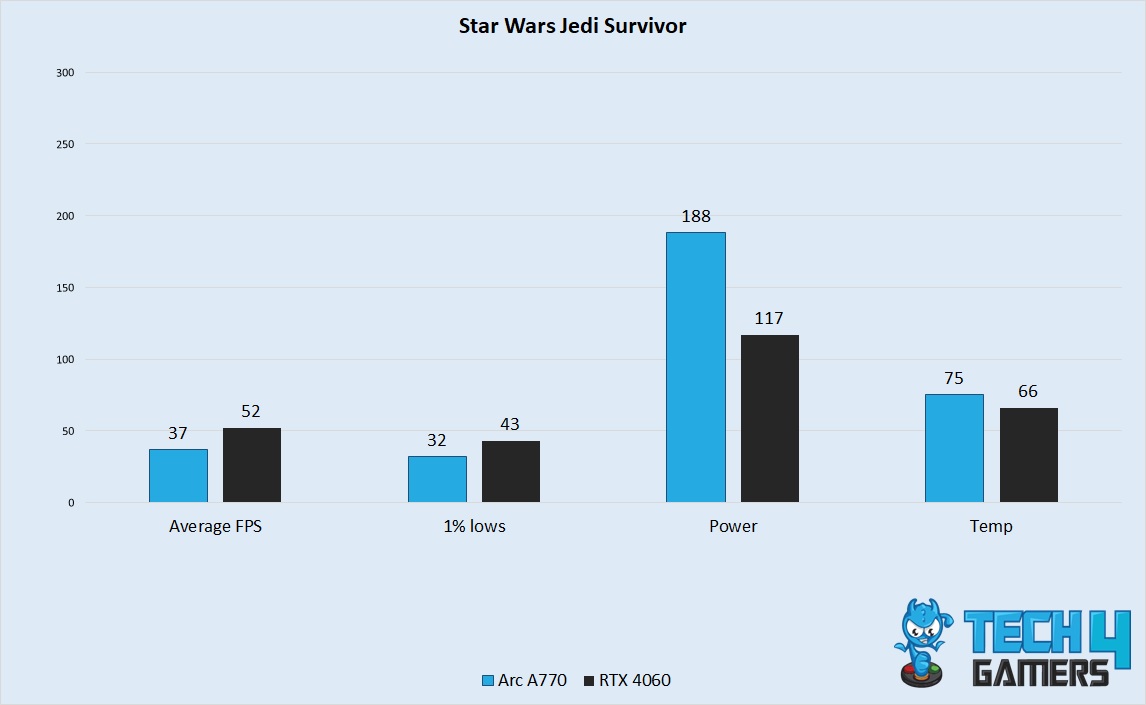
- Being a less optimized game, Star Wars Jedi Survivor did not run great on either card. The RTX 4060 had a barely playable 52 FPS, whereas the Arc A770 had an average of 37 FPS.
- The Arc A770 had 1% lows of about 32 FPS, whereas the RTX 4060 had higher 1% lows of about 43 FPS.
Atomic Heart (Native)
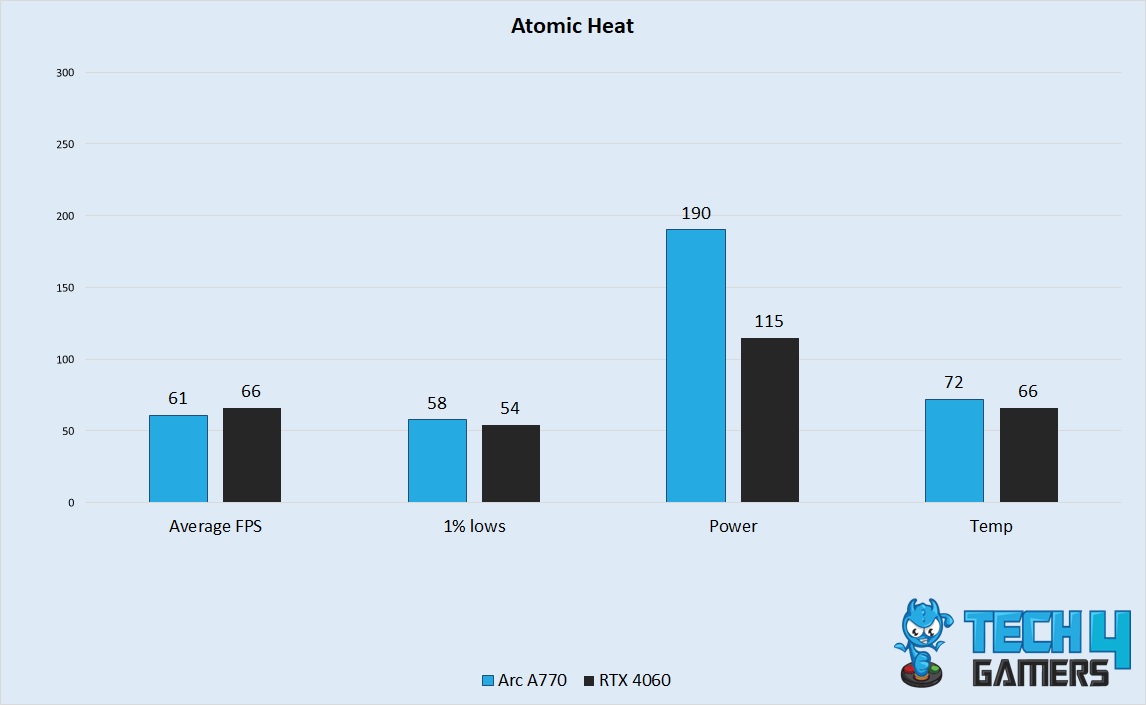
- This controversial game ran similarly on both cards. The Arc A770 managed to get 61 FPS, whereas the RTX 4060 still eked out a victory with 66 FPS.
- The 1% lows were also acceptable for this game. The RTX 4060 had lows of 54 FPS, whereas the Arc A770 had 58 FPS as its lows.
Dying Light 2 (Native)
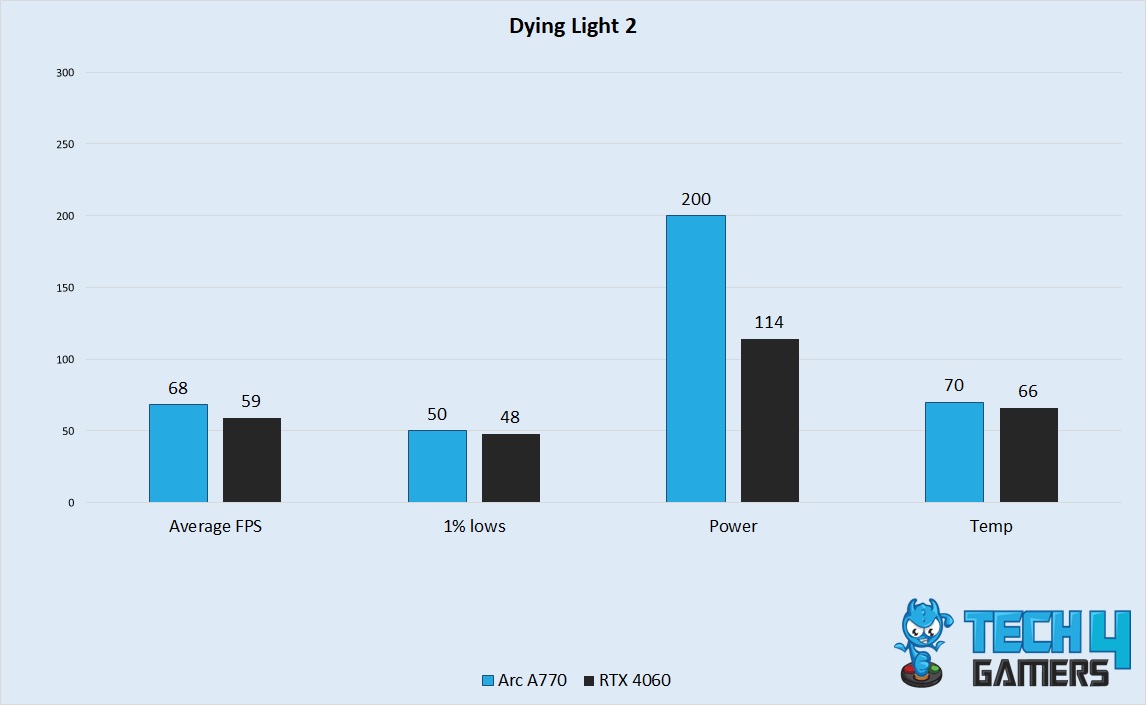
- Dying Light 2 managed to run better on the Intel card. It had an average framerate of about 68 FPS on the A770, whereas the RTX 4060 managed to get about 59 FPS.
- 1% lows were closer between the two cards than the average FPS. The Arc A770 had lows of about 50 FPS, whereas the RTX 4060 had lows closer to 48 FPS.
Microsoft Flight Simulator 2020 (DLSS 3/FSR Q)
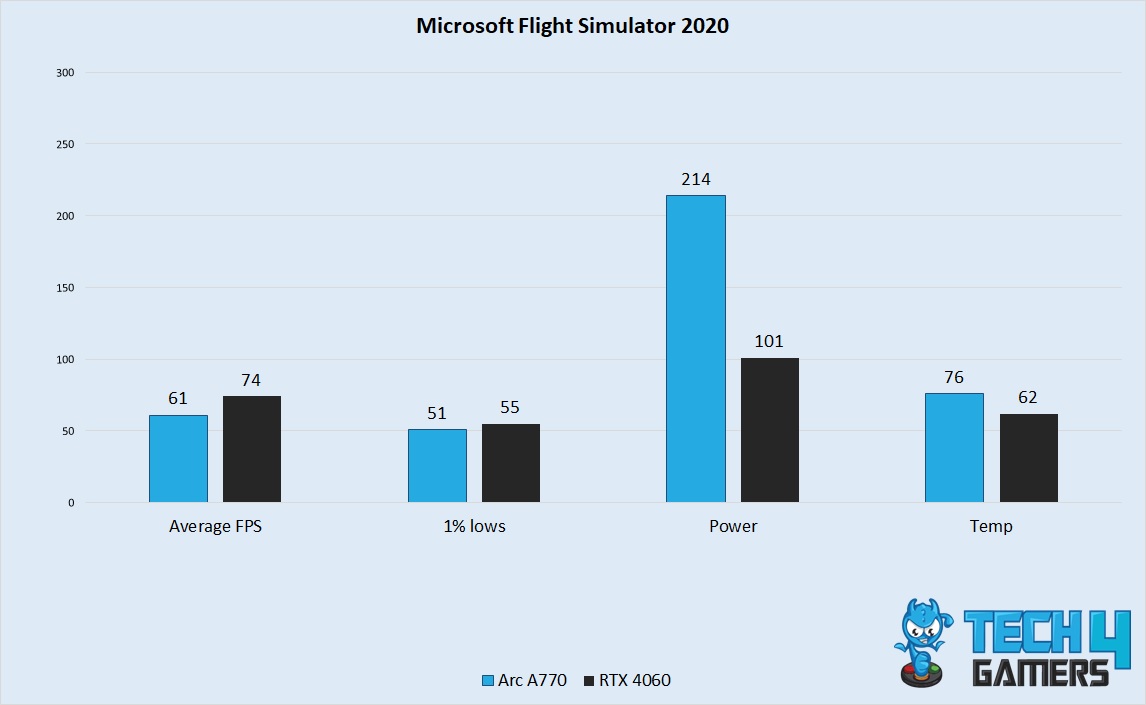
- The winning streak of the Arc A770 ended when we booted up Flight Sim 2020 on both cards. The RTX 4060 managed to get 74 FPS, whereas the Arc A770 got 61 FPS.
- 1% lows were closer between the two cards than their average framerate. The RTX 4060 had 1% lows of 55 FPS, whereas the Arc A770 had lows closer to 51 FPS.
Doom Eternal (Native)
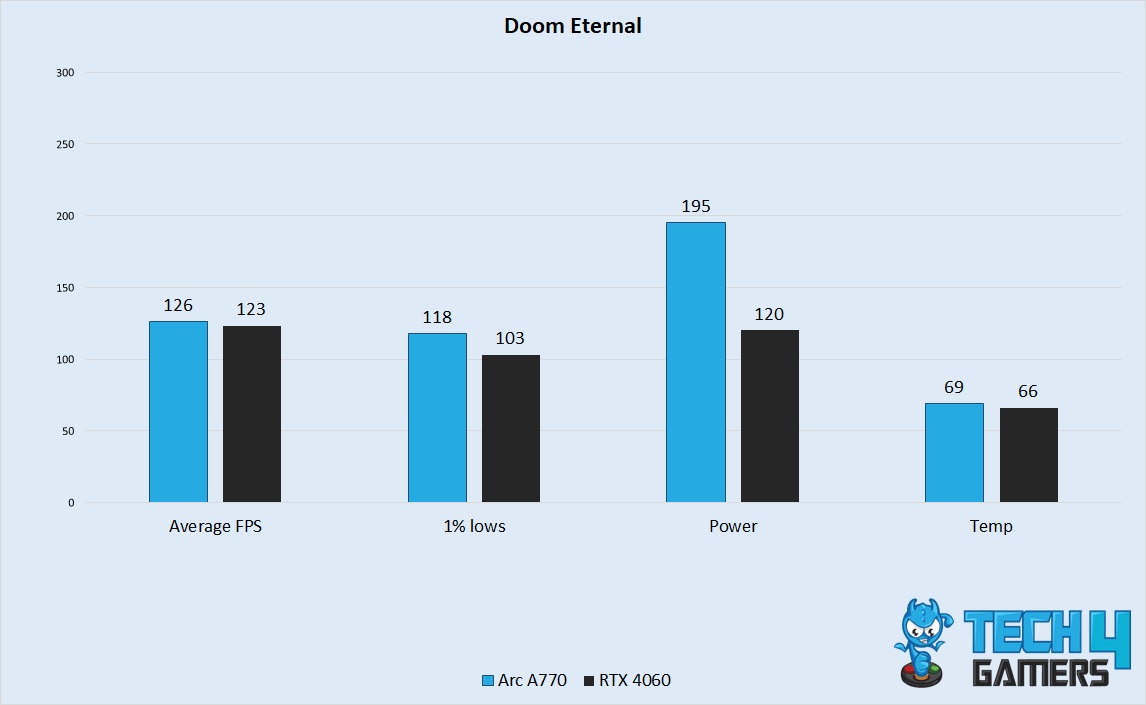
- The Arc A770 can keep up with the RTX 4060. The A770 averaged a framerate of 126 FPS in this game, whereas the RTX 4060 got a framerate of 123 FPS while playing the game.
- 1% lows were also better on the Arc graphics card. It had a 1% lows of 118 FPS, whereas the RTX 4060 came in at 103 FPS.
The Last Of Us (DLSS 2/ FSR Q)
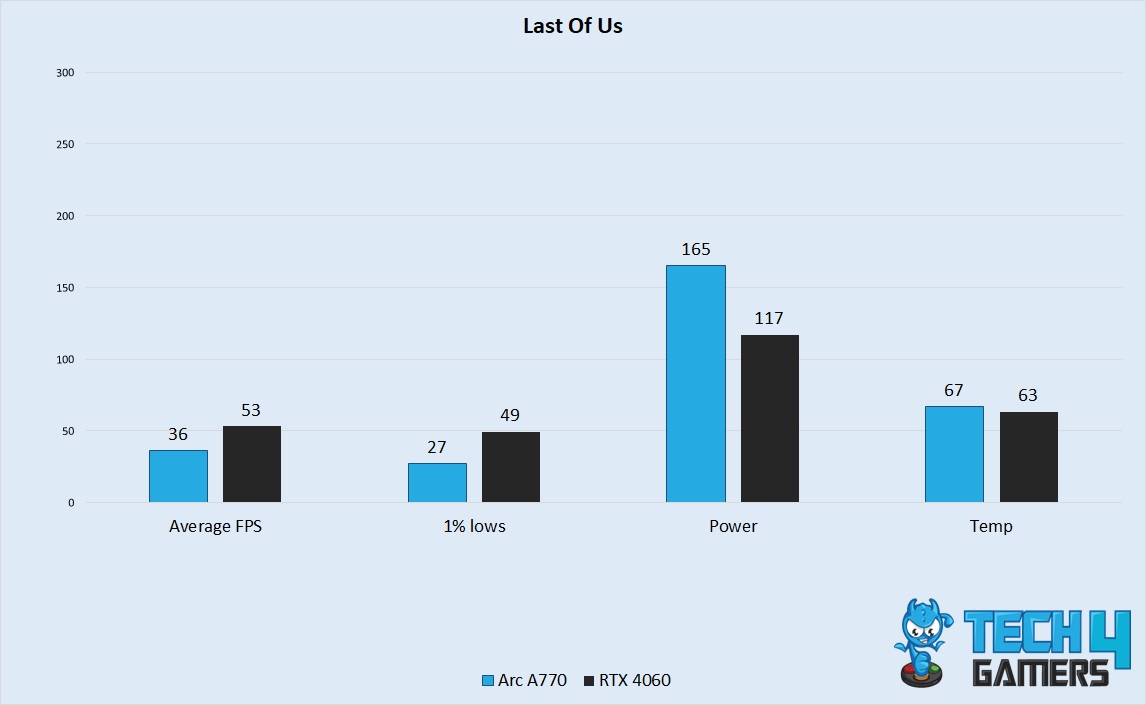
- Coming to the last game of our tests, the RTX 4060 had an average framerate of 53 FPS, whereas the Arc A770 had an average of 36 FPS.
- The Arc A770 had a 1% lows of 27 FPS, whereas the RTX 4060 had a 1% lows of 49 FPS.
Overall Gaming Performance
| Featured | Arc A770 | RTX 4060 |
|---|---|---|
| Average FPS | 62📈 | 70📈 |
| %1 lows | 52📉 | 58📉 |
| Winner: NVIDIA's RTX 4060 | ||
The Arc A770 had an average framerate of 62 FPS in the seven games tested, whereas the RTX 4060 managed to get 70 FPS on average. The Arc A770 had 52 FPS in terms of 1% lows, whereas the RTX 4060 had 1% lows of 58 FPS.
Power
| Featured | Arc A770 (W) | RTX 4060 (W) |
|---|---|---|
| Average Power Consumption | 195⚡️ | 115⚡️ |
| Winner: NVIDIA's RTX 4060 | ||
The Arc A770 used 69% more power than the RTX card. The Arc A770 had an average power consumption of around 195 watts in the games tested today. The RTX 4060 was much more power efficient, with an average power consumption matching its TDP of 115 watts.
Temperature
| Featured | Arc A770 (°C) | RTX 4060 (°C) |
|---|---|---|
| Average Temperature | 72🌡️ | 65🌡️ |
| Winner: NVIDIA's RTX 4060 | ||
The Arc A770 had a toasty average temperature of 72°C in the games tested. On the other hand, the RTX 4060 remained relatively cool, with an average temperature of about 65°C in the benchmarks we ran.
Price And Availability
| GPU | MSRP | Current Price |
|---|---|---|
| Nvidia RTX 4060 | 💲299 | 💲295 |
| Intel Arc A770 | 💲329 | 💲299 |
| Difference | 10% | 1.3% |
As for availability, the RTX 4060 should be present at any PC parts store of your choosing, though the unpopularity of the Arc A770 might make it hard to pin down.
Final Verdict – What We Recommend?
Nvidia RTX 4060: The RTX 4060 emerges as a clear winner, boasting superior gaming performance across various titles compared to the Intel Arc A770. With an average framerate advantage of approximately 13% and remarkable thermal efficiency operating at an average temperature of approximately 10% cooler, the RTX 4060 offers exceptional gaming experiences.
Intel Arc A770: The Intel Arc A770 falls short in gaming performance and power efficiency compared to the RTX 4060. Despite its manufacturing using a more advanced 6nm process, the Arc A770 consumes approximately 69% more power on average and exhibits higher temperatures during gaming scenarios.
The RTX 4060 is the preferred choice for gamers prioritizing high-performance gaming experiences, efficient power consumption, and superior thermal management. On the other hand, the Intel Arc A770, while offering impressive hardware specifications, may appeal to users interested in products with potential for optimization.
Frequently Asked Questions
Though the card’s hardware is exceptional for the price, it has some drawbacks, like the driver support, that make it less than ideal as a daily driver.
The RTX 4060 packs a lot of performance for its size due to its use of an advanced manufacturing process, allowing Nvidia to build dense circuits.
Yes, for some games. Frame generation only works well when the game is already rendered at a smooth FPS, ideally above 40. Any game that runs at 60 FPS after using frame generation will not provide an enjoyable experience.
More From RTX 4060
More From Intel Arc A770
Thank you! Please share your positive feedback. 🔋
How could we improve this post? Please Help us. 😔
[Comparisons Expert]
Abdemanaf is a skilled creative writer who has been honing his craft since 2011. While initially working in different fields, he found a passion for technology and has been exploring the tech world since early 2015. Over the years, he has developed an in-depth knowledge of the latest tech trends and product offerings by various companies.
Abdemanaf’s writing reflects his analytical mindset and ability to think critically. He has a knack for breaking down complex technical information into easily digestible pieces, making his articles engaging and accessible to readers from all backgrounds. In February 2022, he joined Tech4Gamers as a blog and product comparison writer, where he has been able to hone his skills further.
As a writer, Abdemanaf is dedicated to staying up-to-date with the latest technological advancements and trends, enabling him to provide readers with the most relevant and accurate information. He is always eager to learn more and is constantly seeking new challenges to improve his skills.
Get In Touch: manaf@tech4gamers.com


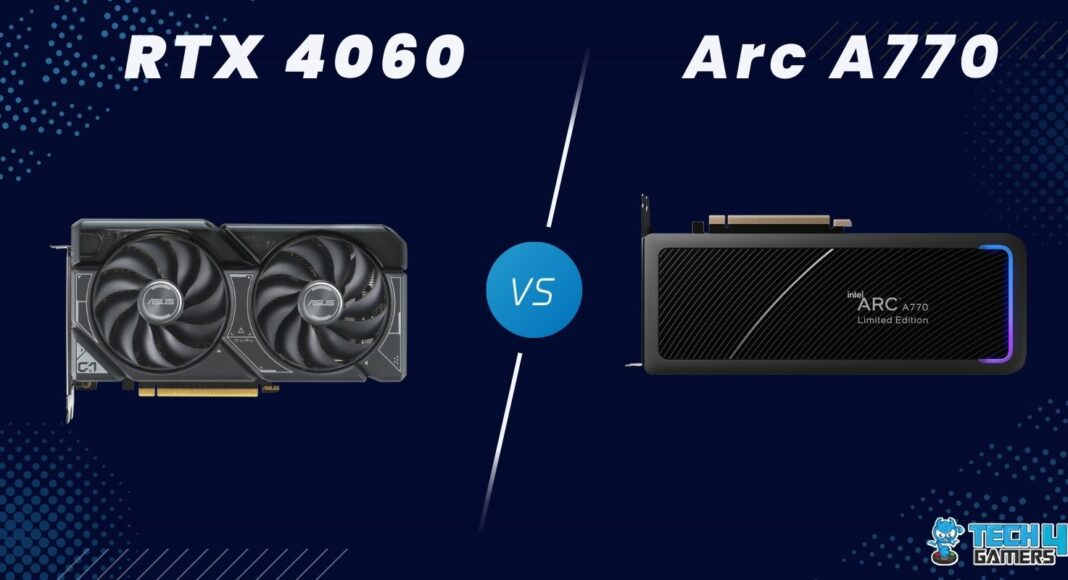
![RX 7700 XT vs RTX 3060 Ti [Gaming Results 2025]](https://tech4gamers.com/wp-content/uploads/2024/01/RX-7700-XT-vs-RTX-3060-Ti-218x150.jpg)
![Ryzen 9 7950X Vs Ryzen 9 7900X [We Tested 10 Games] Ryzen 9 7950x Vs Ryzen 9 7900x](https://tech4gamers.com/wp-content/uploads/2022/10/Ryzen-9-7950x-Vs-Ryzen-9-7900x-218x150.jpg)

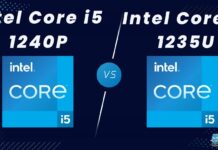
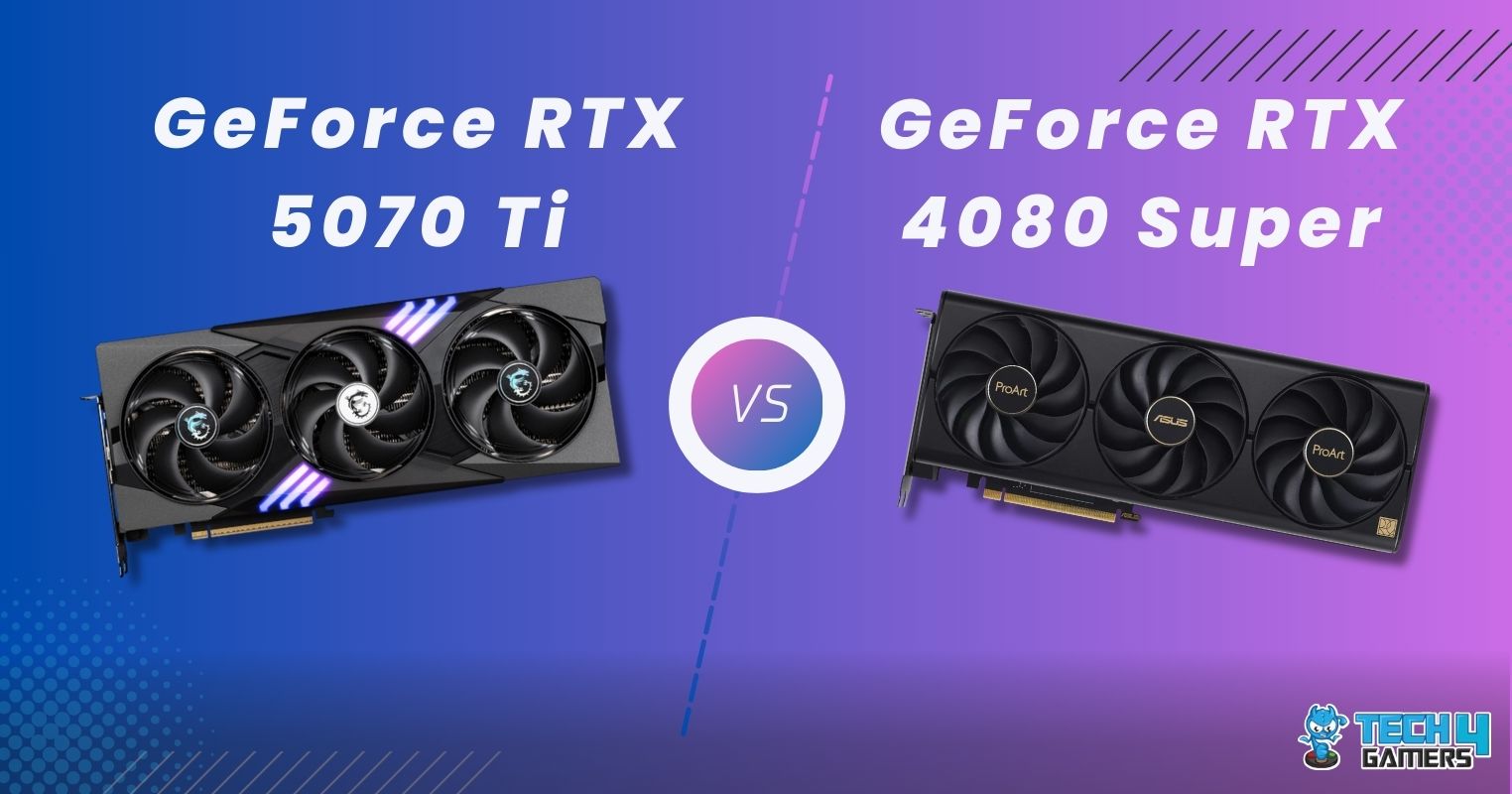
Feedback By: